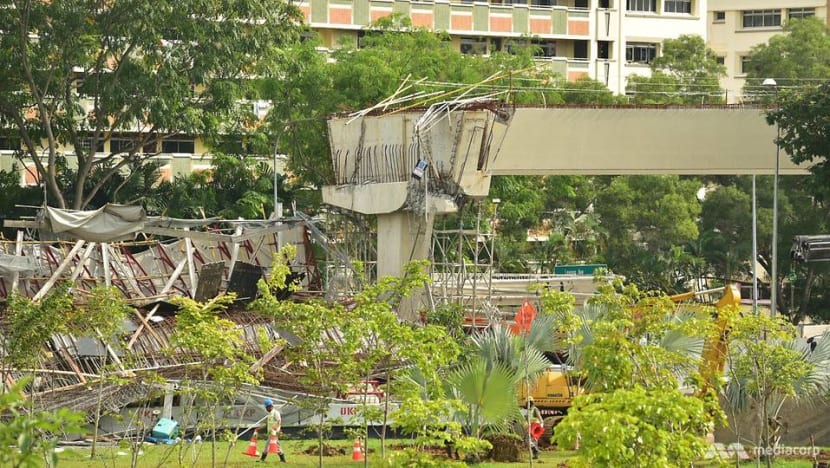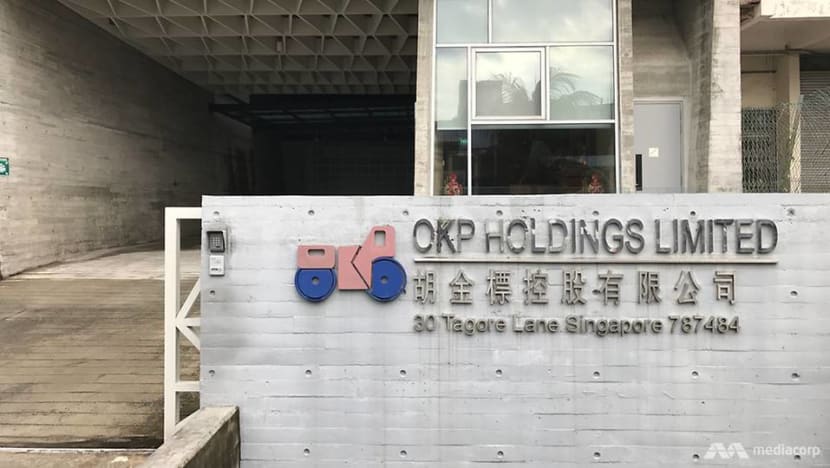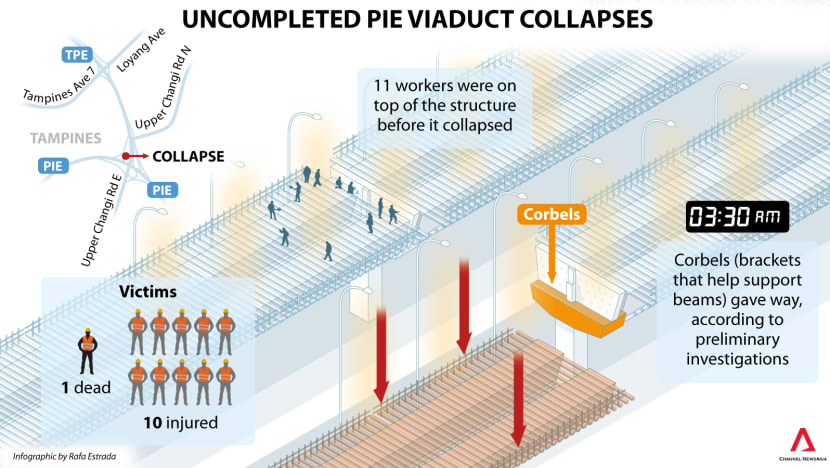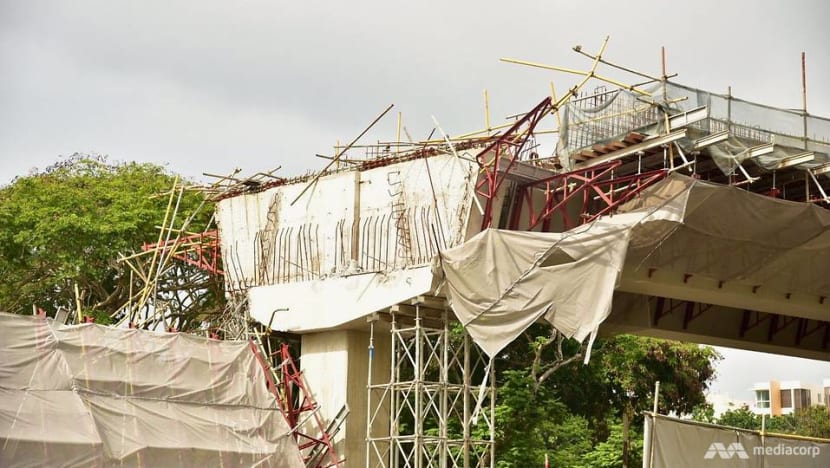PIE viaduct trial: Cracks spotted 3 times before collapse, builder unaware of errors in initial design

An uncompleted viaduct near the Pan-Island Expressway (PIE) collapsed on Jul 14, 2017. (Photo: Gaya Chandramohan)
SINGAPORE: There were warning signs before a section of a viaduct under construction gave way in the early morning of Jul 14, 2017, killing a worker and injuring 10 others who were on top of it.
A month before the incident, employees of builder Or Kim Peow (OKP) Contractors were aware of cracks in support structures, but did not inform the registered professional engineer of the project, Robert Arianto Tjandra.
When cracks were found a second time, Tjandra ordered checks and learned about errors in the initial design of corbels - support structures meant to distribute the vehicular load - but did not inform OKP.
READ: Contractor in fatal viaduct collapse won bid with low safety score, lowest tender price, says MOT
READ: Accredited checker admits not performing checks for support structures
On the day of the incident, the project engineer saw cracks on the corbels at the section of the viaduct that later collapsed, and sent photos of them to the project director, but neither of them stopped the construction works.
This was part of the case that the prosecution will build against OKP and three other accused individuals over the collapse of the viaduct from Tampines Expressway to the Pan Island Expressway and Upper Changi Road East, it was revealed in court at the opening of the trial on Thursday (Aug 1).
CHARGES FACED BY BUILDER AND THREE MEN
The three men contesting charges are: Tjandra, 46, who was employed by CPG consultants and acted as the qualified person for design and supervision of the project; Wong Kiew Hai, 31, the project engineer working for OKP; and OKP project director Yee Chee Keong, 49.
Tjandra faces the most number of charges - four charges under the Building Control Act and one charge under the Workplace Safety and Health Act.
Wong and Yee face a charge each of recklessly endangering the safety of everyone on the portion of the viaduct that collapsed - between piers 40 and 41 - when they discovered cracks on the corbels on the day of the incident but failed to cease all works.
Both men are also accused of obstructing the course of justice by deleting a WhatsApp conversation between the two of them that contained photographs of the cracks on corbels at piers 40 and 41.

The Land Transport Authority-appointed builder OKP faces a single charge under the Workplace Safety and Health Act for failing to take necessary measures to ensure the safety and health of its workers who were casting the deck slab on the day of the incident.
READ: Charges against managing director of builder Or Kim Peow withdrawn
The prosecution, led by deputy public prosecutors Kristy Tan and Yang Ziliang, detailed in its opening address how various parties involved in the project allegedly acted when they discovered potential problems in construction.
CRACKS FOUND AS EARLY AS A MONTH BEFORE INCIDENT
The viaduct was designed to be 1.8km long, with 50 spans in between piers, and each span divided into eight flyovers.
The section that collapsed was the 43.5m-long span between piers 40 and 41, in flyover 7. This was also the longest span in the flyover. The corbels that failed were support structures connecting columns to the girders between piers, and the ends of each girder rested on one corbel.
Cracks in corbels were discovered as early as a month before the incident, said the prosecution. OKP employees discovered the cracks on the face of the pier 41 corbel on Jun 16, 2017, after launching precast girders between piers 40 and 41.
Yee was among those allegedly aware of these cracks. OKP’s technical director and registered professional engineer Yeung Chun Keung assessed the cracks on-site and found that they were structural cracks due to bearing failure.
The builder joined two plinths - segments that rested on top of the corbels - into a single piece to increase contact surface based on Mr Yeung’s recommendation.

However, OKP did not inform Tjandra of these cracks.
More cracks were found later that month, this time on the corbels of pier 42. One of OKP’s project engineers, Goh Ee Hui, saw the cracks on Jun 30, 2017.
Mr Goh immediately reported the cracks to Yee. Mr Yeung returned to the site again and assessed the cracks, finding them once again to be structural cracks. He told Yee to ask Tjandra to check on the adequacy of the design of the crossheads.
After Yee told Tjandra about the cracks, Tjandra conducted a site inspection on Jul 3, 2017 and instructed CPG’s design engineers to check on the adequacy of the corbel designs for the entire project.
ERRORS IN INITIAL CORBEL DESIGN UNCOVERED
It is the prosecution’s case that the CPG design engineers discovered by early July 2017 that the wrong corbel width assumption had been used in the design of the corbels, including those used in the span that later collapsed.
They had wrongly assumed that the effective width of the corbel was longer than what it should be, and as a result of this error, the capacity of many corbels was inadequate for the loads they were intended to carry.

Tjandra had not picked up these errors at the time of the initial design, said the prosecution. However, he became aware of them by early July 2017 after the CPG design engineers conducted checks, and did not tell OKP of the errors in the design.
He also did not redesign the corbels in piers 40 and 41 to ensure they would have the adequate capacity, the prosecution claimed.
TJANDRA DID NOT TELL OKP ABOUT ERRORS, TOOK OTHER STEPS
However, Tjandra did take other steps. On Jul 5, 2017, he sent Yee a revised construction sequence for the deck slab casting works for piers 40 and 41. He instructed the erection of 12 props under each of the crossheads at both piers, and directed OKP to cast 50 per cent of the length of the deck slab during the first stage casting instead of 75 per cent, which was what had been done for deck slabs between other piers.
Tjandra also directed OKP to stitch precast girders to the crosshead before the second stage casting, so that the load would not go down to the corbel but go to the crosshead that had been stitched to the precast girders.
Even though he revised the construction sequence in three ways, Tjandra did not inspect the installation of the props and checked the installation remotely by exchanging WhatsApp messages with Yee four days before the collapse.
He also issued a series of instructions to OKP to insert additional rebars into other corbels to reinforce them, which the builder did.
DESPITE STEPS TAKEN, STRUCTURE COLLAPSED AFTER CASTING
On the day of the incident, OKP began the first stage deck slab casting for the segment between piers 40 and 41 at 1.30am.
Less than two hours later at 2.53am, cracks appeared on the corbels at piers 40 and 41. They were seen by project engineer Wong, CPG’s resident engineer Sivanathan Shenthan, OKP’s safety supervisor Victor Tan and LTA site supervisor Syed Mohammed Farique Feshal Syed Salim Alattas.

Wong called Yee, who was not at the site, and sent him photos of the cracks via WhatsApp. Other personnel at the site, including Mr Farique, urged Wong to stop the casting works.
However, they continued.
At around 3.25am, the corbels at piers 40 and 41 gave away, resulting in the collapse of the structure and the concrete that had been poured between the two piers that morning.
After the accident, Wong and Yee deleted the conversation “in haste to bury their responsibility”, said the prosecution.
WARNING SIGNS UNHEEDED PLACED WORKERS IN DANGER
The prosecution on Thursday told the court in its opening address that there were warning signs prior to the collapse that had not been heeded.
“Had the works been promptly halted, the workers could have been out of danger,” said the prosecutors.
Instead, 31-year-old China national Chen Yinchuan was pronounced dead at the scene at 4.35am that morning, and 10 other workers suffered injuries ranging from fractures of the spine, pelvis and limbs to lacerations and abrasions.
The prosecution intends to call expert witnesses to testify that the collapse was caused by the failure of corbels at piers 40 and 41 due to overloading, and that there was a failure in the design, as the corbels were not designed to take the bending and shear induced by loads during the casting of the deck slab.
Tjandra is defended by a team of lawyers from Rajah & Tann, led by Senior Counsel Lee Eng Beng, while Wong and Yee are represented by lawyers from Tan Rajah & Cheah, led by Senior Counsel Chelva R Rajah.
OKP has appointed a team from WongPartnership as its lawyers, headed by Senior Counsel Alvin Yeo.
The trial continues this afternoon.














